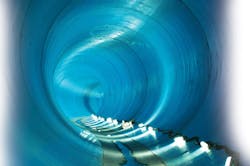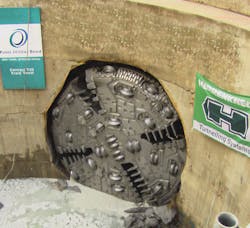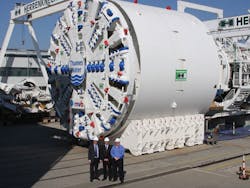Digging Deep in Singapore: Getting Ready for DTSS Phase II
With Phase 1 of Singapore's Deep Tunnel Sewerage System (DTSS) complete, what will Phase 2 mean for the island? How will this project revolutionise wastewater treatment in Singapore and link into the previous tunnel? Tom Freyberg investigates.
Just as WWi was going to print, the decision emerged on which major consultancy has won Singapore's Deep Tunnel Sewerage System (DTSS) Phase 2 project.
According to the original schedule, construction on the second phase of Singapore's DTSS project should have started on January 1st 2014. However, delays have affected the decision on which consultant should take on the enormous multi-billion dollar project
CH2M Hill, Arup and a joint venture between Black & Veatch(B&V)/AECOM were among those shortlisted and which submitted tender documents before the 24 October deadline in 2013.
CH2M Hill could have been seen as one of the favourites to win this project – having undertaken Phase 1, as well as currently undertaking similar projects in Qatar and Abu Dhabi. Yet it was actually the B&V/Aecom joint venture that was successful, WWi has learned.
Following the open pre-qualification exercise which was called in March 2013, the B&V+AECOM JV team has been selected by PUB, Singapore's national water agency, to provide engineering services for Phase 2 of the Deep Tunnel Sewerage System (DTSS).
Although an official announcement is expected in June, the B&V/AECOM joint venture team exclusively told WWi: "Following the open pre-qualification exercise which was called in March 2013, the B&V+AECOM JV team has been selected by PUB, Singapore's national water agency, to provide engineering services for Phase 2 of the Deep Tunnel Sewerage System (DTSS). We proposed a compelling team and technical solution through our joint venture and look forward to sharing more details once all details have been finalised with PUB."
"Belt and braces" approach
With the engineering challenge of Phase 2 yet to start, it's perhaps a good time to reflect upon Phase 1. At a cost of US$2.7 billion, DTSS's first phase was at the time considered one of Asia's largest engineering projects.
Covering the north and east of the island, the engineering and construction work for the deep sewer tunnels, the link sewers, Changi water reclamation plant (WRP) and the Changi outfall were broken down into nearly 50 main consultants and contractors and 300 sub-contractors and suppliers. Work started in 1997 and was completed in 2008.
The deep tunnel component included 48km of large diameter sewer tunnels built up to 50m below the ground. A total of eight tunnel boring machines (TBMs) ranging up to 7.2m in diameter were used. Although now heralded as a success, the project was not without its challenges.
"It was some of the most onerous conditions you could wish to meet for a tunnel boring machine," says a source close to the project. "At 50m deep, facing 5 bars hydrostatic pressures, the tunnelling went from fresh granite into soft ground and back into granite on the upstream tunnels."
A source close to the tender process told WWi that: "The link sewers contracted to local contractors didn't go as well as planned. The link sewer contracts were sized so that local contractors could bid for them.
"Some of these smaller firms were not as experienced in pipe-jacking work as the larger, international companies and ran into challenges completing the link sewer sections. PUB and their programme manager will use the lessons learned from DTSS 1 to ensure that similar challenges are mitigated prior to construction during DTSS 2."
DTSS 1 was constructed with a 100 year design life. A corrosion protection lining was installed to help mitigate the sulphuric acid generated by the high sewage temperatures in Singapore from attacking the lining.
A HDPE primary lining was then used, followed by over 200mm of reinforced concrete for the secondary lining. This was cast against the structural lining of the pre-cast concrete segments.
A DTSS 1 source says: "For sewer tunnels subject to potentially severe corrosion, such as will be encountered on the DTSS 2 tunnels, it should be looked at whether to use a one pass lining using polymer concrete rather than a two-pass lining with structural lining and then a secondary corrosion protection lining.
"The "belt and braces" approach of a two-pass lining is best when dealing with such a critical asset. If you're putting something in the ground for 100 years you really need something that is absolutely reliable."
Operation and Maintenance
Although the first part of the island-wide DTSS is complete, incorporating best practices from newer DTSS to the operation and maintenance procedures of the deep tunnel sewer will likely be a focus for PUB heading into DTSS 2.
System resiliency will be a primary consideration. Some of these best practices include installing access shafts every 1.5 km. These can then be used to launch remotely operated vehicles (ROVs).
Mounted cameras inspect the area of the tunnel above the waterline and sonar technology is used to inspect below the waterline. As well as a shorter, 18km deep tunnel, Phase 2 will also include a new WRP in Tuas and a co-located water reuse – NEWater – plant.
There is also a 12-month study to consider the feasibility of co-locating an integrated waste management facility at the Tuas site. The study will address how a co-located waste plant would work with the Tuas WRP. The potential is there for a two-way relationship: energy from waste could be off taken by the water plant and clean water sent back.
One STEP for man, one giant leap for deep tunnels
Singapore is not the only nation undergoing an enormous tunnelling project. Abu Dhabi in the UAE is undergoing a US$1.5 billion Strategic Tunnel Enhancement Programme (STEP).
The 40km deep sewer tunnel, up to 80m underground, includes new link sewers and a pumping station.
Meanwhile Qatar's Public Works Authority – Ashghal – is undergoing the Inner Doha Re-sewerage Implementation Strategy (IDRIS).
The 40 km long deep trunk sewer programme will include over 70 km of lateral inceptor sewers. It will provide a long-term solution to serve the needs of Doha, Al Wakra and Messaieed.
London, too, is undergoing the Thames Tideway project – a 25km tunnel running 80m under the River Thames.
Eventually the project should help alleviate pressure off of old Victorian sewers that come under strain with storm water during periods of heavy rain. Labelled the "super sewer", the project is worth £2.8 billion (US$4.6 billion).
Singapore is already ahead of the pack when it comes to water management. All eyes and ears of the industry are awaiting the decision from PUB on DTSS 2 - a project that will eventually put it even further ahead and create infrastructure that could last 100 years.
Tom Freyberg is chief editor of WWi magazine. Email: [email protected]



